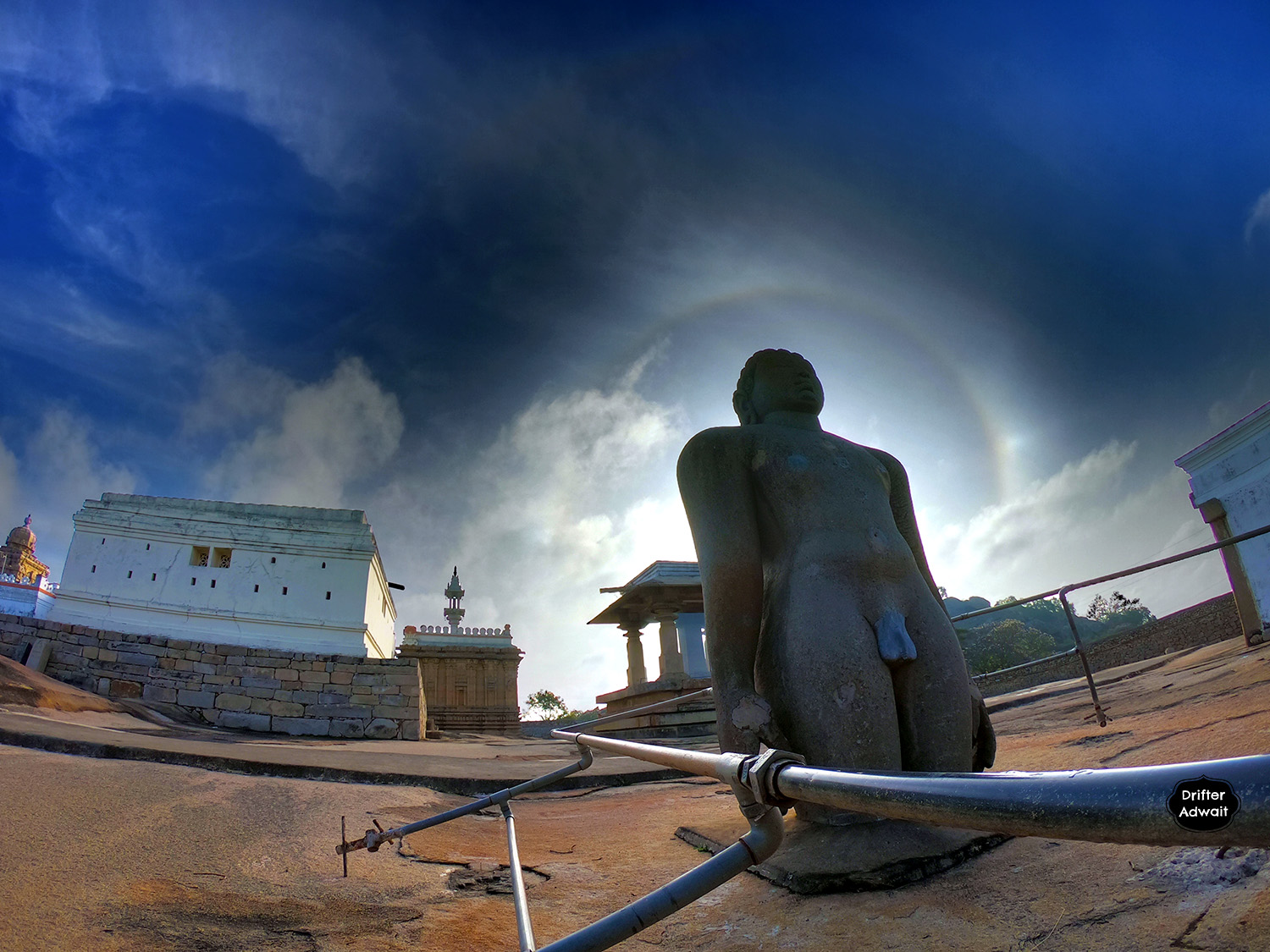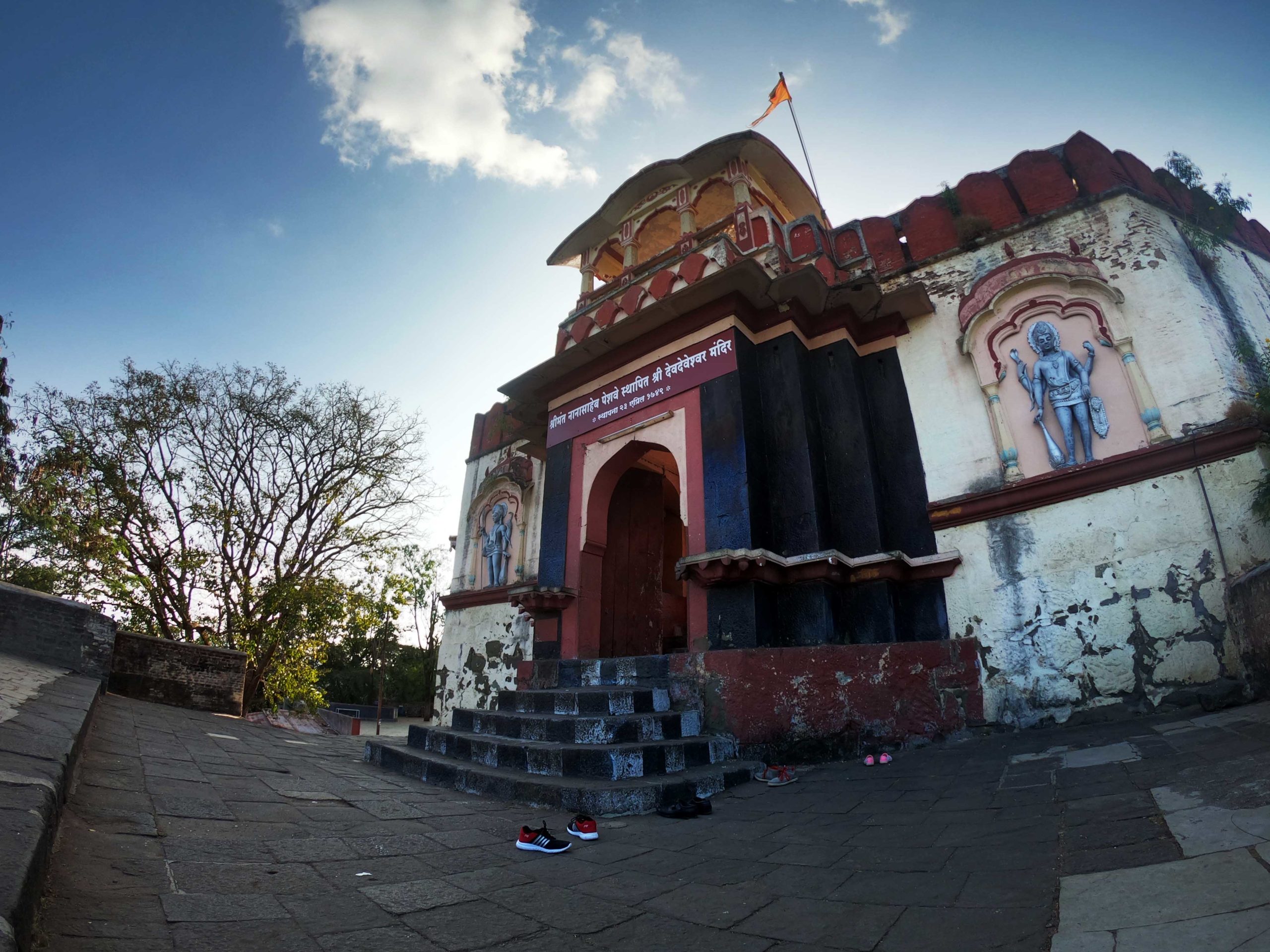Welcome to my blog, where I explore the fascinating world of temple architecture, and today I will be focusing on the awe-inspiring Chandragiri Temple Complex, situated atop a historic hill in Shravanbelagola, Karnataka, India. This stunning temple complex is not only renowned for its exquisite architecture and intricate carvings, but also for its historical significance, as it is the final resting place of India’s first emperor, Chandragupta Maurya.
As I visited this magnificent temple complex, I was struck by the sheer grandeur of the site, with its towering monolithic statues and intricate rock-cut architecture. The temple complex is dedicated to Lord Chandragupta Maurya, and is believed to have been built during the 9th century AD.
The Chandragiri Temple Complex is not only a magnificent example of Indian temple architecture, but also a site of immense historical and cultural importance. It is a testament to the rich cultural heritage of India, and a place where visitors can learn about the fascinating history of the Mauryan dynasty.
Join me as I delve into the fascinating world of temple architecture, and explore the intricate details and rich history of the Chandragiri Temple Complex. Let’s begin!!!
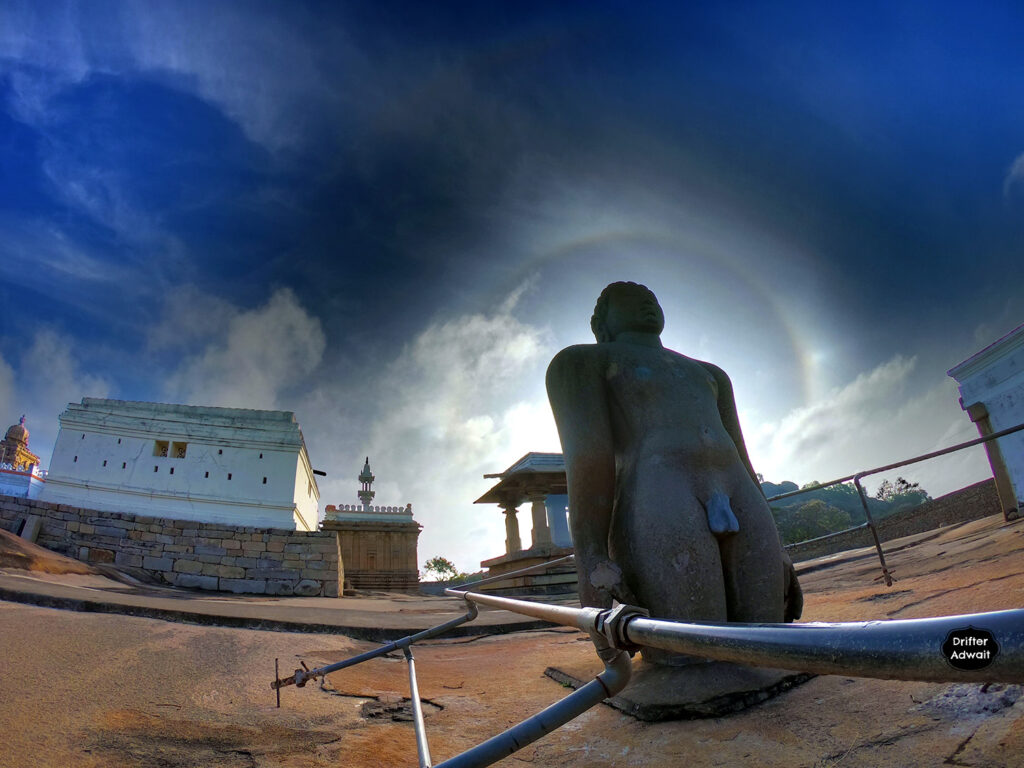
Mangalore is one of the favorite weekend gateways for Bangalore techies. As Friday evening approaches, they start making plans to spend some “Quality Time” on the Panamur or Ullal beach. Saturday morning, they start early, rushing in their TUVs and SUVs on smooth NH75 highways towards the western coastline. As they get closer to Chennarayapattana, after village Hirisave, the national highway rolls towards the west, and one small road goes towards the south.
Here, we have to say good buys to our techie friends as we have to take a road less traveled, zigzagging through small villages, surrounded by the sea of coconut plantations. After driving for about 20 km, we reach the historic town of Shravanbelagola, having a history of not less than 2300 years.
Main population of the town Shravanbelagola is Jain pilgrims. Bahubali is world’s tallest monolith statue, carved more than thousand years ago. Every day, thousands of Jain devotees come here, to pay tribute to the Sage Bahubali, who left his kingdom to his brother and walked on the path of absolute knowledge.
Very few tourists, having keen interest in history, arts and archaeology come to wonder here, on the hillock of Vindhyagiri, where ancient statue of Bahubali welcomes them. Among these interested few, a very little percentage bother to climb down Vindhyagiri hill, wear their shoes, walk across the pond, and start climbing the next mountain after removing their footwear again.
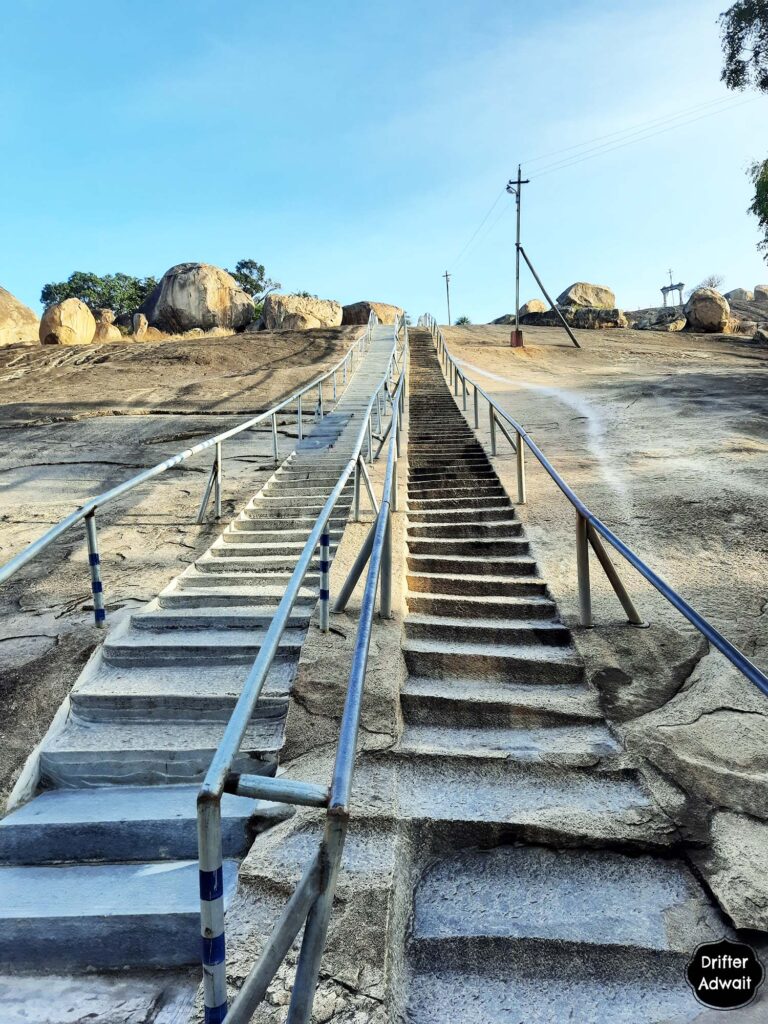
On the other side of the white pond, there lies another hill, with boulders all around it. Surrounded by a vijaynagar timed stone wall, the top of the hill have 14 different Basadis, or, temples. Thousands of year ago, many came here, sacrificing everything, in search of the salvation, knowledge and liberation. Few of them were honoured with monuments, constructed on their names on the hillock of Chandragiri. One of them belongs to the legendary emperor of India- Chandragupta Maurya.
Chandragupta Maurya and Shravanbelagoal:
It was indeed the golden era of India. Under the guidance of Chanakya, his brilliant student Chandragupta Maurya had gathered all the Kingdoms under the umbrella of his command and managed to expel the armies of Alexander the great out of the holy land of India. In 322BC, just Chandragupta was ruling the entire Indian subcontinent with an iron fist and tender heart.
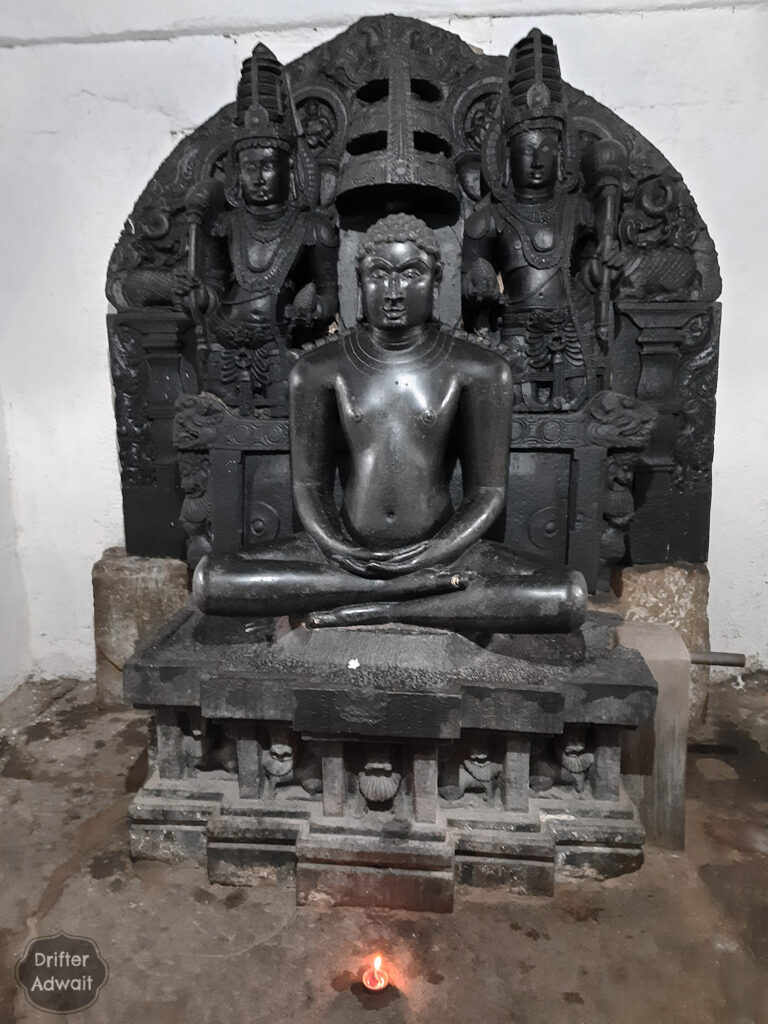
Jain scriptures describe the tale afterward. One night, Chandragupta viewed 16 nightmares at once. Curious, Chandragupta wanted to know the meaning of these dreams he saw. At the same time, he got the news that Jain monk Antim Shrutakevali Bhadrabahu Swami has arrived in Ujjain, along with his 12000 disciples.
Curious, Chandragupta then met with Bhadrabahu, describing the 16 nightmares to him. Bhadrabahu explained that these dreams announce stoicism and the tough times ahead.
Once, Bhadrabahu was invited to a devotee named Jinadas Seth, where he met a two-month-old infant. When lord Bhadrabahu approached the kid, he started repeating, ‘Go Away, Go Away’. Amused, Bhadrabahu asked, ‘for how many years?’, For twelve years, the kid replied and started to suck on his thumb with a calming smile.
With the wisdom, Bhadrabahu got to know about the upcoming 12-year drought the empire will face, and hence, along with his 12000 disciples, he started walking south. Chandragupta transferred his kingdom to his son Bindusara, and wearing the white robes, he became a Jain monk and went along with Bhadrabahu renouncing everything he owned.
As the group reached a small village near Mysore, Bhadrabahu heard the echoes from the skies that his end is near. He sent almost all of his followers further south to spread the word of Jainism, and along with Chandragupta, he stayed back in that village, today known as Shravan Belagol. In a cave, Bhadrabahu started Sallekhana meditation without consuming anything. Few months passed away, and Bhadrabahu left his mortal body in the presence of Chandragupta.

Jain scriptures describe that after the death of his Guru, Chandragupta Maurya stayed there for several years, meditating. Following the footsteps of his Guru, the first emperor of United India, Chandragupta Maurya gradually reduced the intake of food and liquids, and practicing Sallekhana, left the earth peacefully. This is how an ideal student, a legendary fighter, an expert politician, and a legendary King gave up his life searching for the ultimate truth and peace. His whole life, he struggled every day, perfecting perfection, and his achievements were unparallel to any other king in the world.
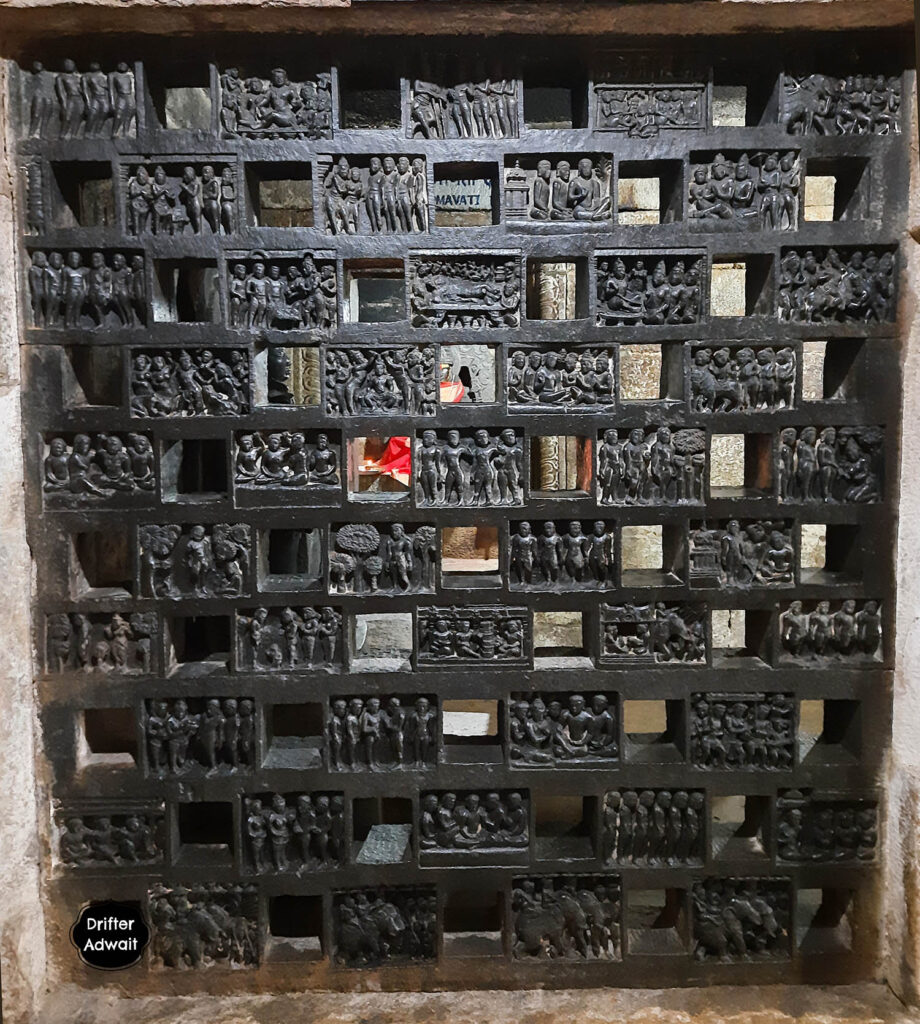
Chandragiri, which is 3052 feet from sea level, is also known as Katavapra, Chikkabeta, and Rushigiri, as per the inscriptions found on the hilltop.
List of Noteworthy Basadis on Chandragiri Hill:
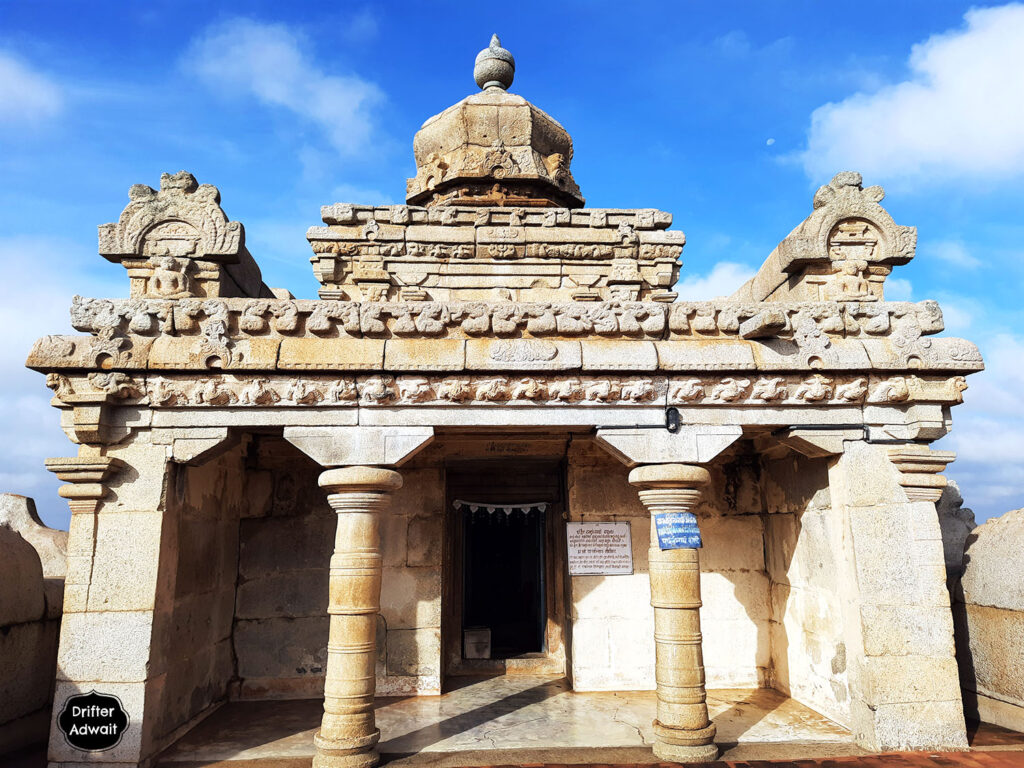
Chavundaraya Basadi, Chandragupta Basadi, Shantinatha Basadi, Parshvanatha Basadi, Kattale Basadi, Majjigana Basadi etc.
There are few more structures, naming Shasana Basadi, Chandraprabha Basadi, Parshwanatha Basadi II, Eradukatte Basadi, Savatigandhavarana Basadi, Terina Basadi, Shantishwara Basadi, and Iruve-Brahmadeva Basadi.
Basadis, dating from 600 AD to 1200 AD, are spread across the hilltop. With that, two distinct architectural features are standing here. One is Vijaya Stambha, and another one is a half-buried statue of King Bharata, brother of Bahubali. All of them are built-in Dravida architecture style.

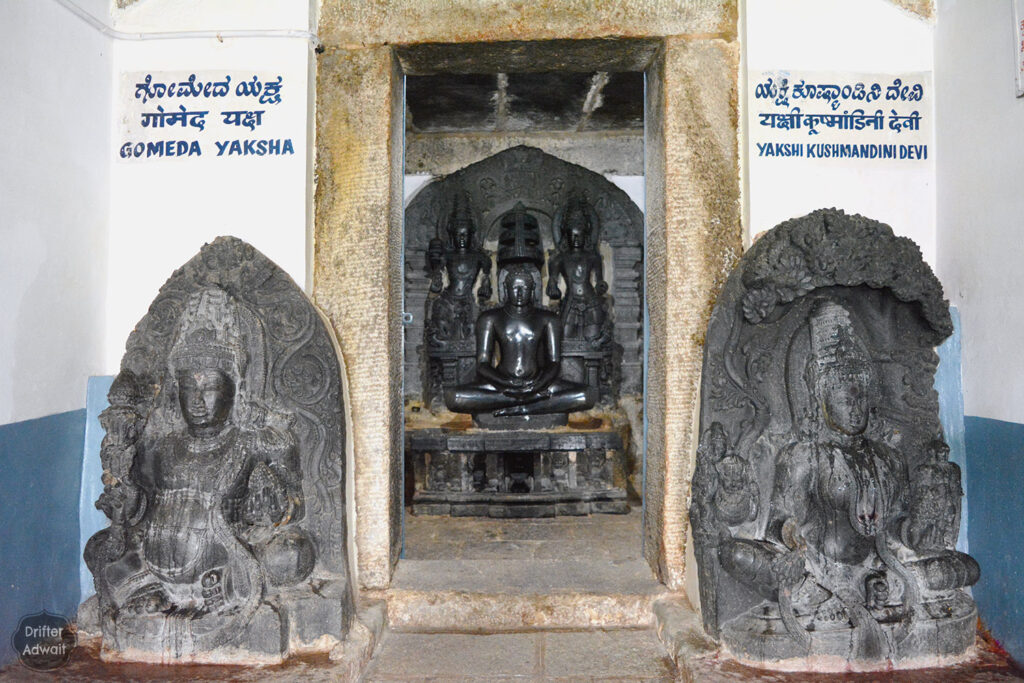
Even though today, these Basadis may look like places of worship, they were much more than that thousand years ago. Also called Chaitalayas or Jainalayas, these temples used to be shelters for the Jain monks. These hillocks used to be crowded with devotees during the auspicious days, being the center of festivities like music and dancing. These were used to be centers of learning, as many students use to stay here, studying the different aspects of humanity.
Inscriptions on Chandragiri Temple Complex Hill:
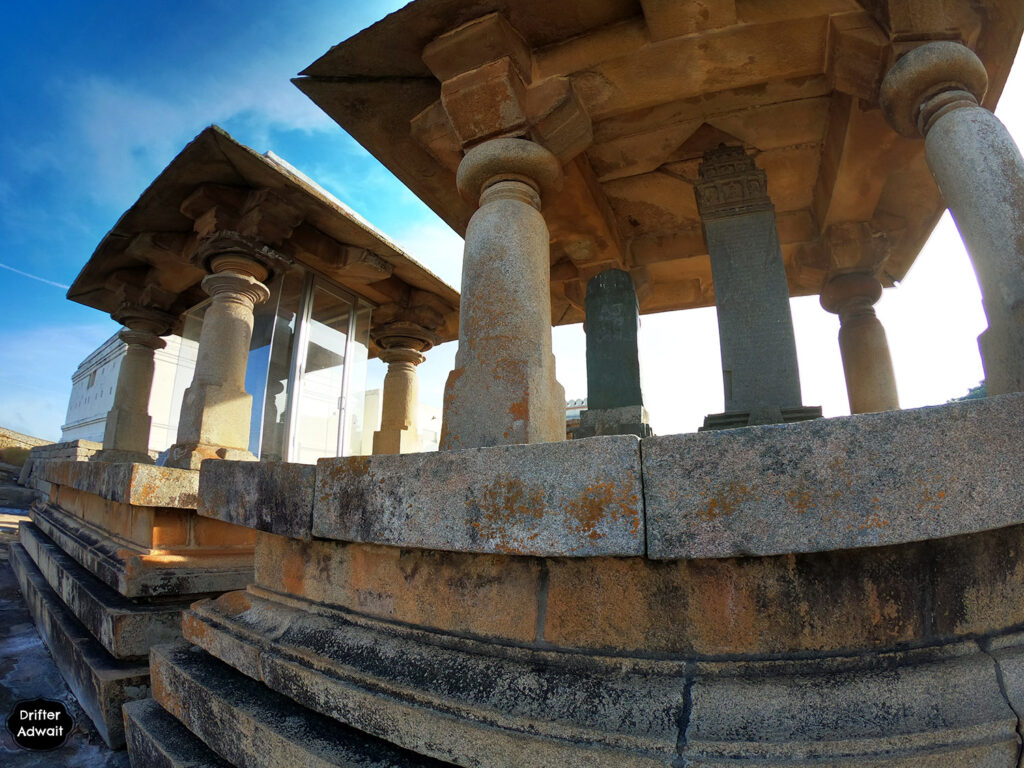
Setting aside the brilliant architecture, Shravan Belagola is home to more than 800 ancient inscriptions. Several hundred inscriptions can be found on the hillock of Chandragiri. Thanks to ASI, almost all the inscriptions have been either covered with the glass or enclosed in the glass cases with the roof on their heads. Many of these inscriptions are written either in the Ganga dynasty era or in the Hoysala era, and you can differentiate between them by the language and the designs. Hoysala era inscriptions are carved on a free-standing slab, a slab of black soapstone.
There is a total of 106 inscriptions found on the Chandragiri itself. They say that till the 9th century, the Chandragiri was the spot for practicing Sallekhana- Voluntarily giving up consuming food and water to gain ultimate control over the body. Among 106 inscriptions, 47 are dedicated to the monks, 9 to the Jain Nuns, and five householders.
Pillars on Chandragiri Hill:
There are two prominent free-standing pillars you will find on the hillock of Chandragiri. One is Kuge Brahma Stambha or Brahma Piller, and the second will be a Vijay Stambha. On Kuge Brahmastambha, Brahma is in a Padmasana position, facing east on top of the pillar. You can see eight elephants at the base of the pillar, holding this free-standing pillar aloof. Standing on three platforms, elephants are accompanied by lions, Digpalas, and musicians.
Marasimha’s Manastambha:
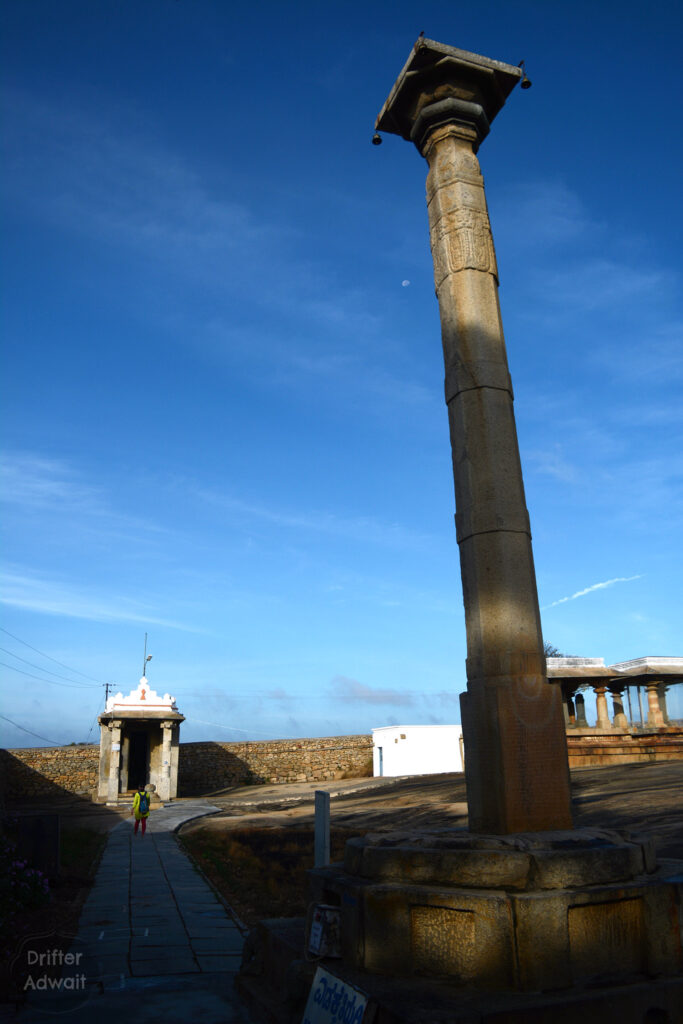
Ancient Jain architectural scriptures say, that
माणुल्लासयमिच्छा वि दूरदो दंसणेण थंभाणं |जं होंति गलिदमाणा माणत्थंभं ति तं भणिदं ||
By looking at this particular pillar even from a far distance, the proud people lose their pride, and this pillar makes them humble. Hence, these types of posts are called Manastambha. In Jain architecture, this pillar can be found near every Jain temple, keeping a certain distance.
As you enter the Chandragiri complex, you stand in front of one free-standing pillar named Manastambha. Inscription on the pillar says that Ganga King Narasimha 2 left his body in 974 AD, observing the rite of Aradhana at the location of Bankapur. So one can guess the age of this ancient pillar accordingly. This 30 feet high pillar is the home of Sarvahana Yaksha on the top. You can see 113 lines engraved on this granite pillar, describing the brilliant accounts of King Marsimha, his heroic life, and his pious demise.
Bhadrabahu Cave, Shravan Belagol:
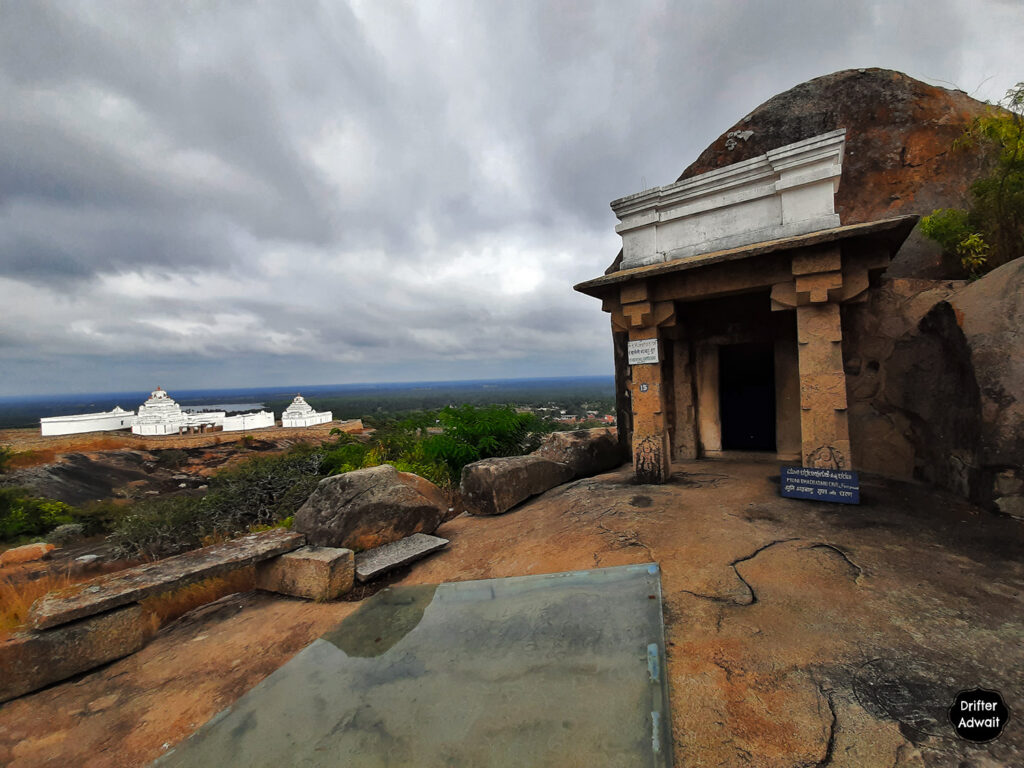
When you get out of the Chandragiri temple complex, take a left, and start climbing the hill in front of you. Keeping the temple complex on your back, when you walk about 100 steps, you will find yourself in front of a cave made up of boulders. This is the same cave where sage Bhadrabahu gave up consuming food and water to leave his body. Two inscriptions, carefully covered with thick glass, can be found at the entrance of the cave. The cave entrance is decorated with an ornate bracket. As you enter the cave, you have to get on your knees to go towards the middle of the cave. Right in the middle of the cave, you can find the footprints of holy sage Bhadrabahu, exactly where he practiced the Sallekhana. Every day, some devotee lights a lamp and decorates these footprints in the carved Mandalas with the flowers found o this hillock.
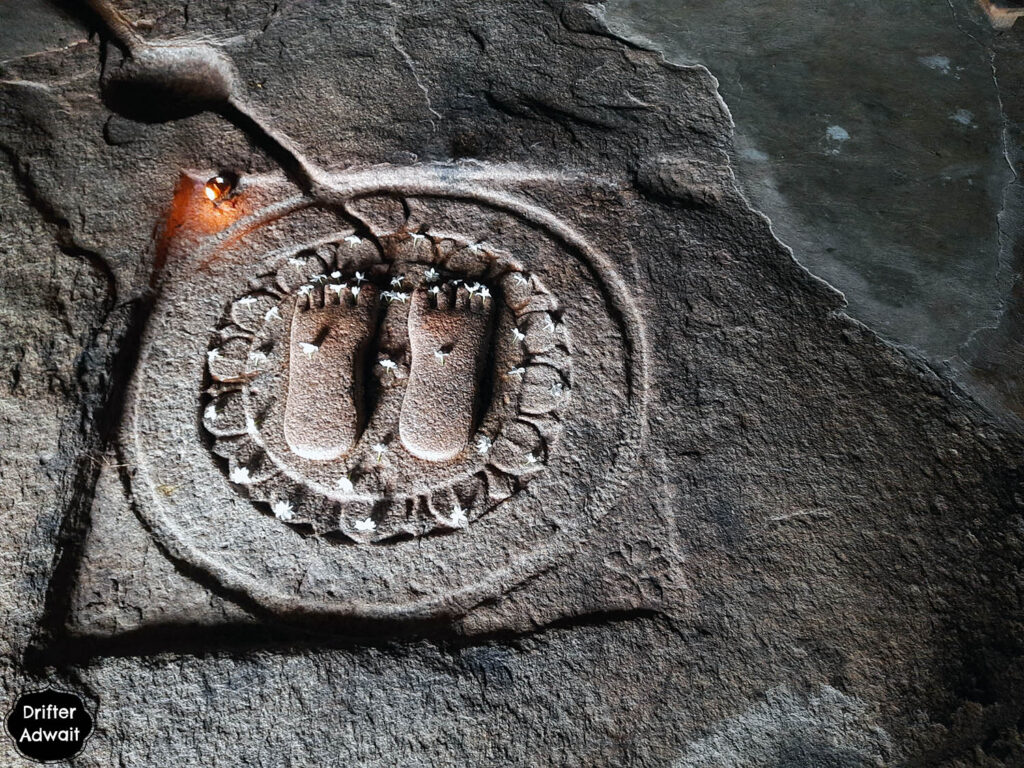
If you want to go further inside the cave, you have to crawl like in any other cave. But do not make a mistake to compare this cave with any other, as this is not just a mere ordinary cave. More than 2300 years ago, one ascetic came here with his emperor turned disciple. They both stayed here. Guru got to know that his end is nearby the awakened consciousness, and hence, he gave up food and water, walking heroically towards death, rather, towards nirvana. Within few years, his emperor disciple followed his footsteps, to be one with the Divine.
Chandragupta’s Dreams and Interpretations of Bhadrabahu

The most brilliant thing about Shravanbelagola is its uniqueness and drama. Two brothers, standing on the top of two hillocks. One looking at another, and another, looking somewhere else, separated by the pond. Another unique feature of this little town is being the home of about 800 ancient inscriptions.
Most of the information on the life of the Chandragupta has been taken from Greek texts and inscriptions. However, for his death, we have to turn towards Jain inscriptions and religious texts, written hundreds of years later on. Even though often disputed, Jain texts describe precisely what happened when Chandragupta decided to come down south.
Chandragupta Basadi, a temple dedicated to Chandragupta Maurya, supports the claims of Jain scriptures. You can find two very unique inscriptions in this temple, or rather windows, ornate with beautiful comic-like strips. These comic-like strips describe what happened after Chandragupta gave away his kingdom to his son and tagged along with sage Bhadrabahu to this small town, seeking peace and salvation.
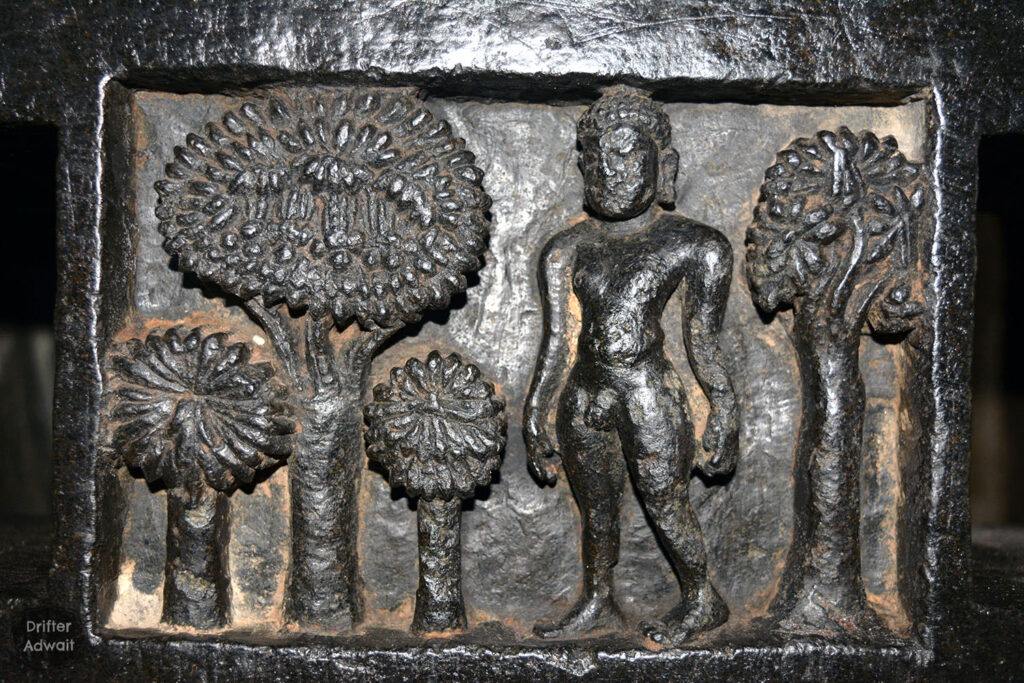

Even though many Jain scriptures support this story, many of them do not. Jainism later got divided into two main sects, viz, Digambar Jainism and Shwetambar Jainism. Many Digambara Jain scriptures claim that the king was Samprati Chandragupta, the grandson of Ashoka and great-grandson of Chandragupta Maurya, who renounced everything and became a Jain monk. According to Indologists like Jeffery D. Long, often, these two Chandragupta get confused with each other. As per the well-known Indologist V. R. Ramachandra Dikshitar, several Digambar Jain scriptures mention Prabhachandra, who usually gets mistaken with Chandragupta Maurya in several ancient scriptures. Nevertheless, these discrepancies do not reduce the historical, spiritual, and cultural importance of this place on the map of the world.
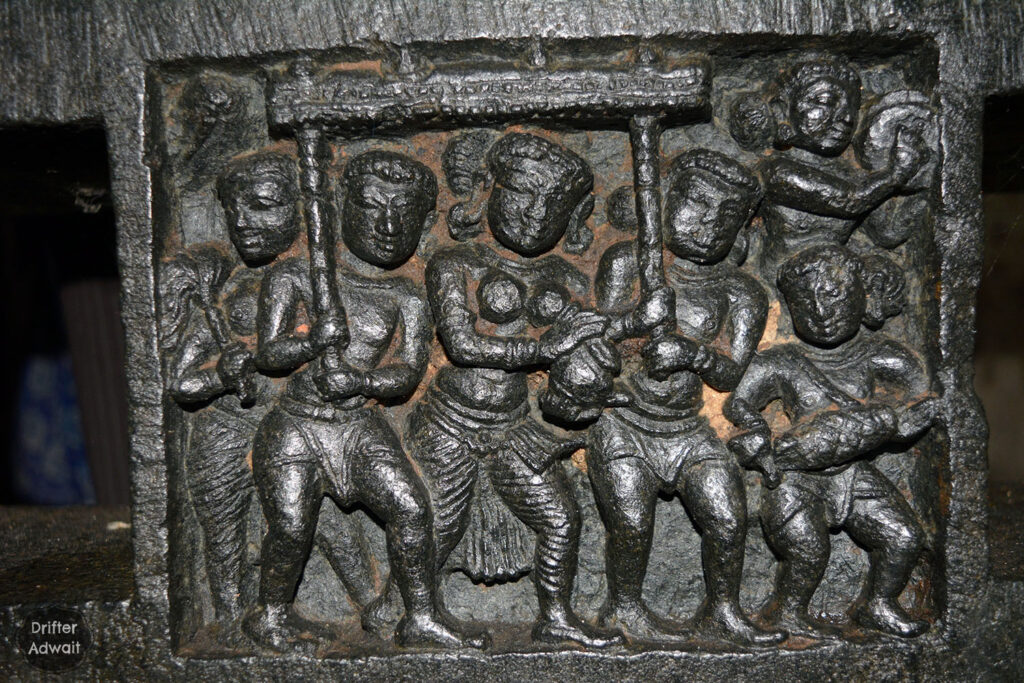
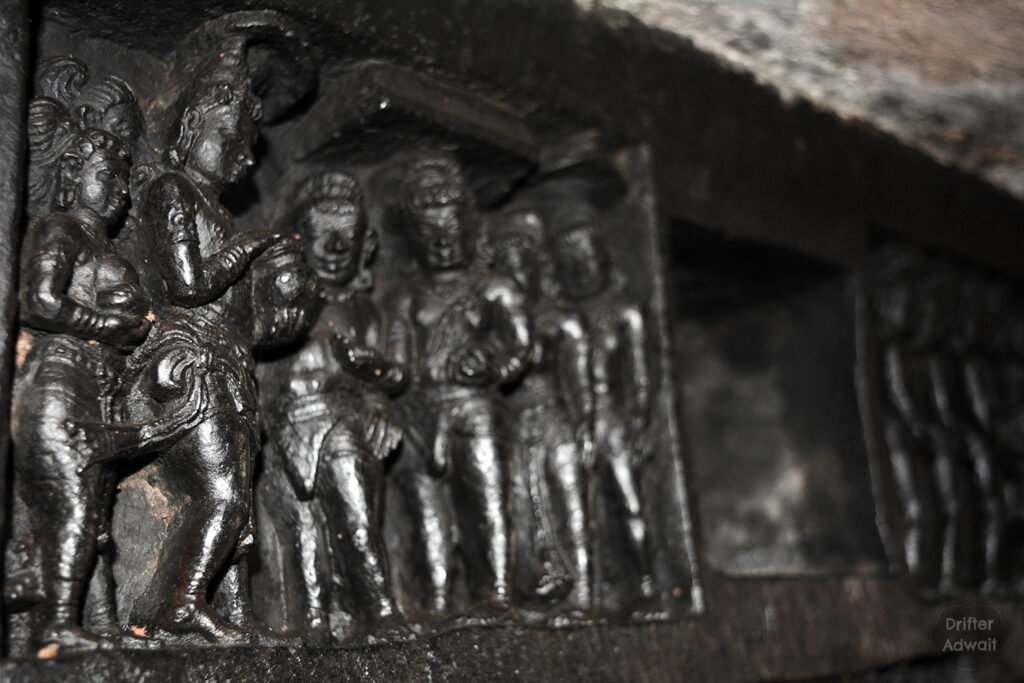
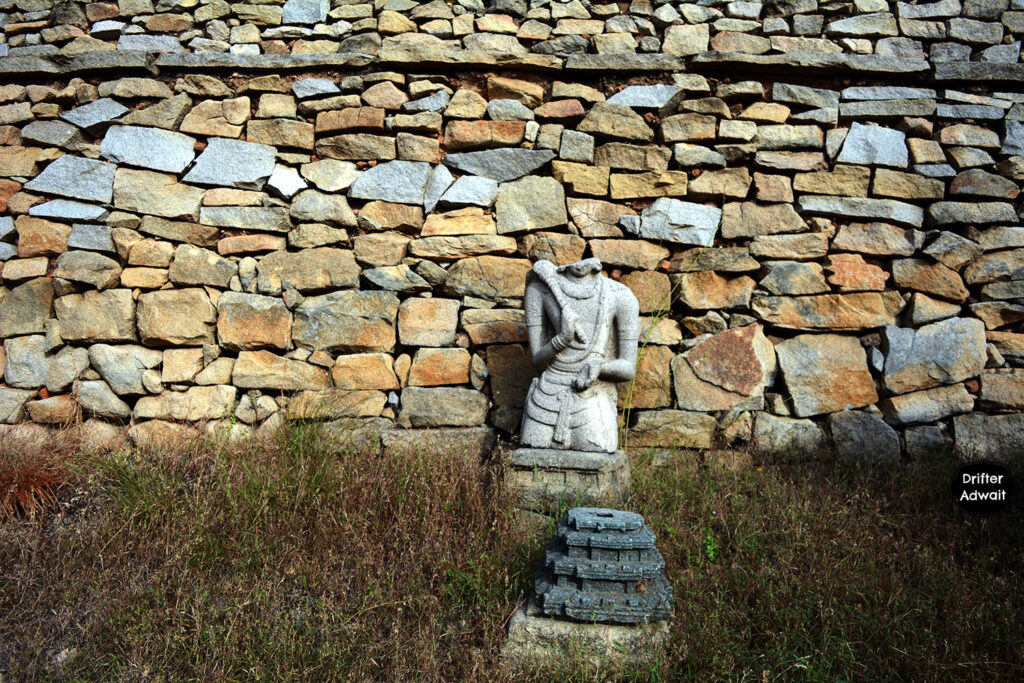
It was 10 am, and the sun was playing hide and seek behind the clouds when we sat beside the Bhadrabahu cave, enjoying the view. We could see ants like Jain pilgrims climbing the next hill at a steady pace, yet the hill we were currently sitting on was deserted. In reality, starving to death is one of the cruelest and saddest ways to die, but when we sat beside that cave, we neither felt sad nor gloomy. Because it was the ultimate choice, made by a highly intellectual human being, to gain superior control over his body while walking towards the higher consciousness, denying worldly pleasures.
That ancient temple complex on Chandragiri was surrounded by the fully blossomed Plumeria trees. Those trees were so much loaded with white flowers that not even a single green leaf was visible. Just like the Plumeria trees, loaded with white flowers, once, this hillock must have been crowded with white-robed Jain monks. We felt like a thousand-year-old past was trying to make a connection with us via these trees.
If we lose 2000 rs note, we keep on searching it for next couple of months. And for the next six months, we cannot stop cursing ourselves for the negligence and glooming over our financial loss. And here, the emperors, who fought for life and death, to teeth and nail, to gain their kingdoms, who gave everything to achieve these vast lands, were giving everything away, without even a second guess. What’s so special in these lands, what’s so unique in the waters of these rivers that make these legendary kings choose absolute knowledge over the kingdoms and give away everything they own?
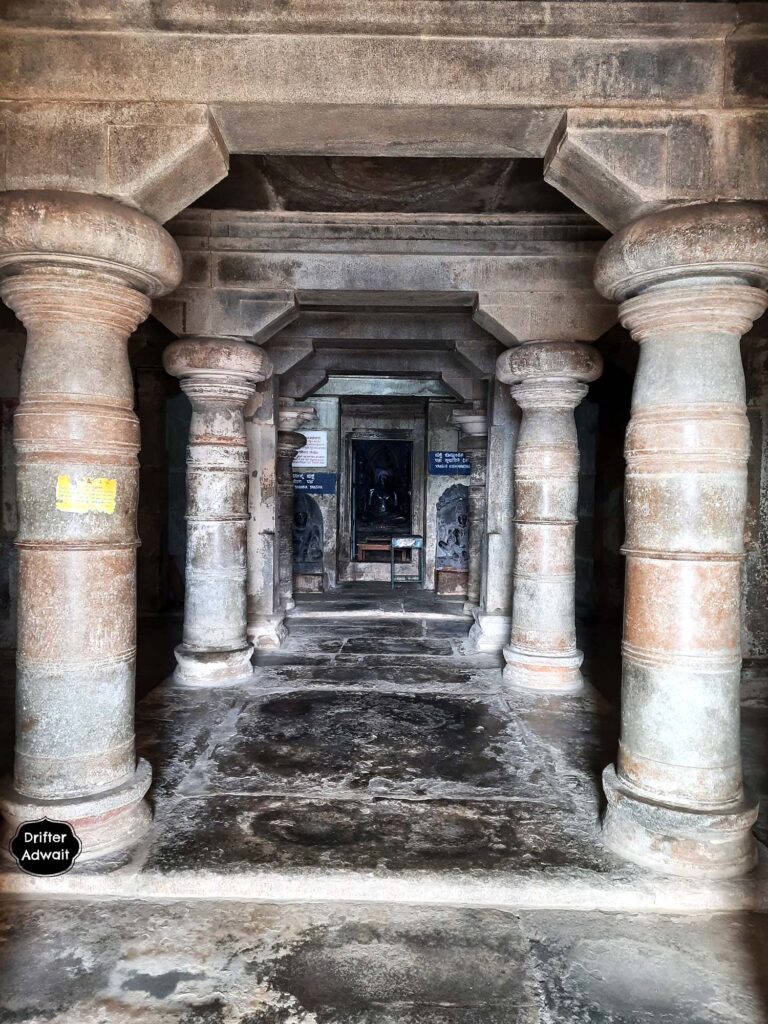

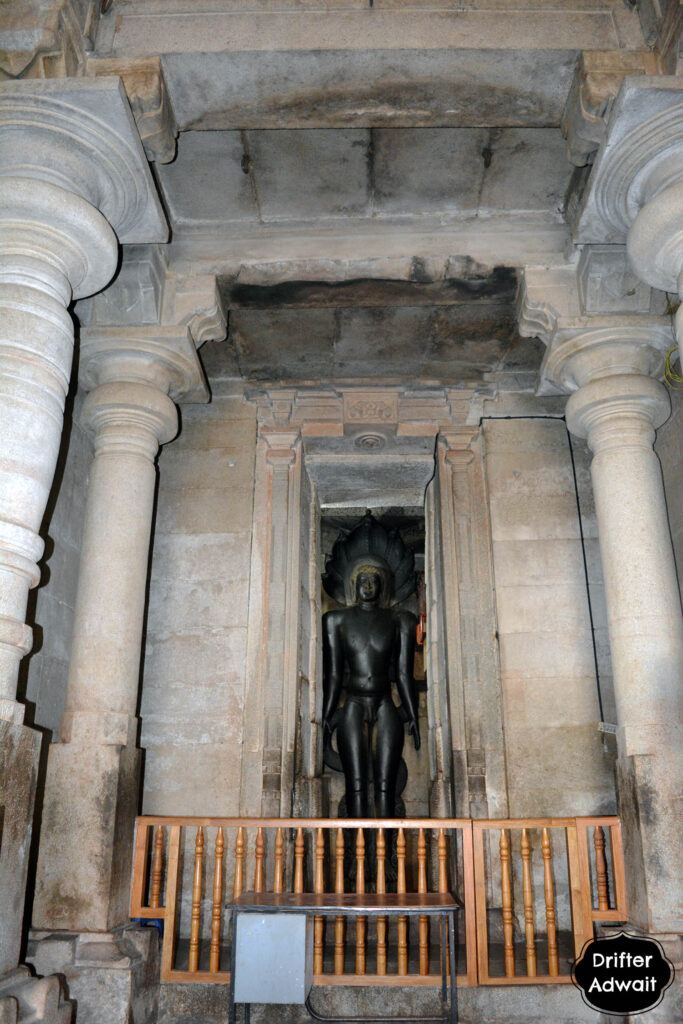
Bahubali and Bharata fought for their fathers’ Kingdoms in a non-violent competition. When Bahubali won the kingdom, he gave it to Bharata and went away to pursue the ultimate knowledge. And remembering his passion and choice, people erected his larger than life sculpture on a mountain, celebrating his ultimate sacrifice. Few years passed away, and walking in his brother’s footsteps, even Bharata chose Jainism and became a monk after resolving his issues with his brother Bahubali. Later, people erected the statue of Bharata on the hillock next to Bahubali’s mountain. But, instead of a full Vigraha, Bharata received the honor in the form of a giant statue, but which starts from his knees. Coincidence? I don’t think so.
How to reach Chandragiri Temple complex, Shravan Belagola?
?150 km from Bangalore, Shravanbelagola is well connected by roads. Drive about 120 KMs on National Highway 75 towards Mangalore, and take a left turn after Hirisave. 20 km drive through dense coconut plantation, you will reach Shravanbelagola.
?There are few buses, which start from KSRTC Majestic depot, reaching Shravanbelagola. However, there are plenty of buses, going every fifteen minutes towards Hassan; you can get down at Hirisave town and get a share auto to Shravanbelagola.
?Shravanbelagola is about 170 KMs from Kempegowda International Airport, Bangalore.
?Shravanbelagol has a railway station, well connected to the main stations in India.
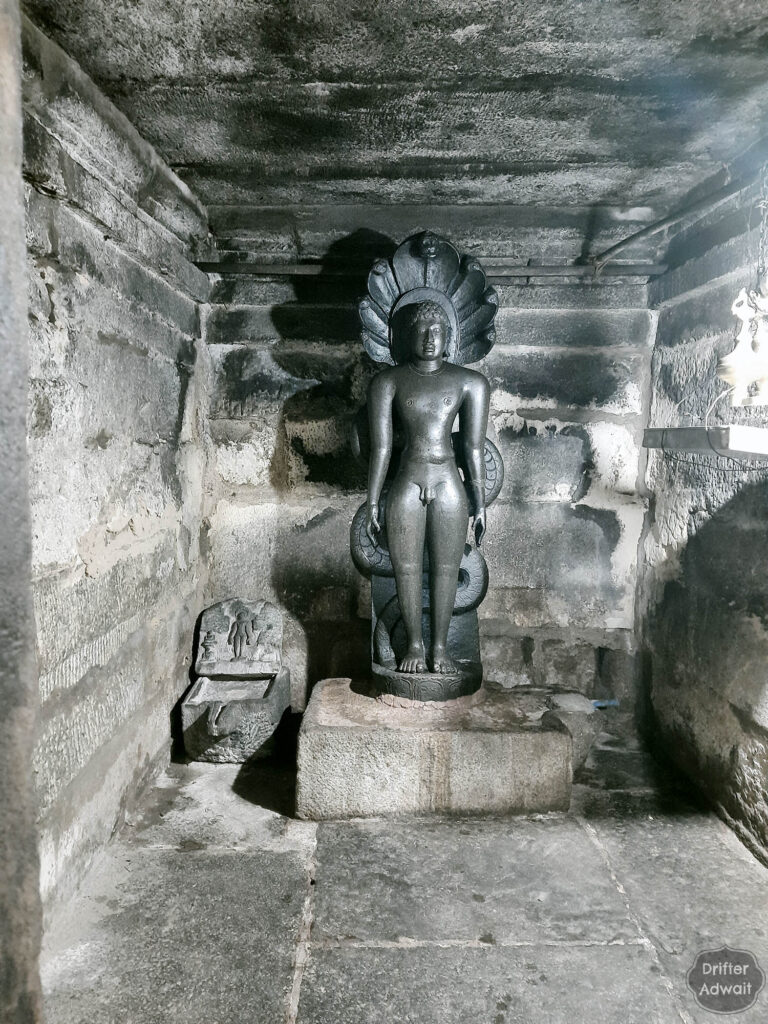


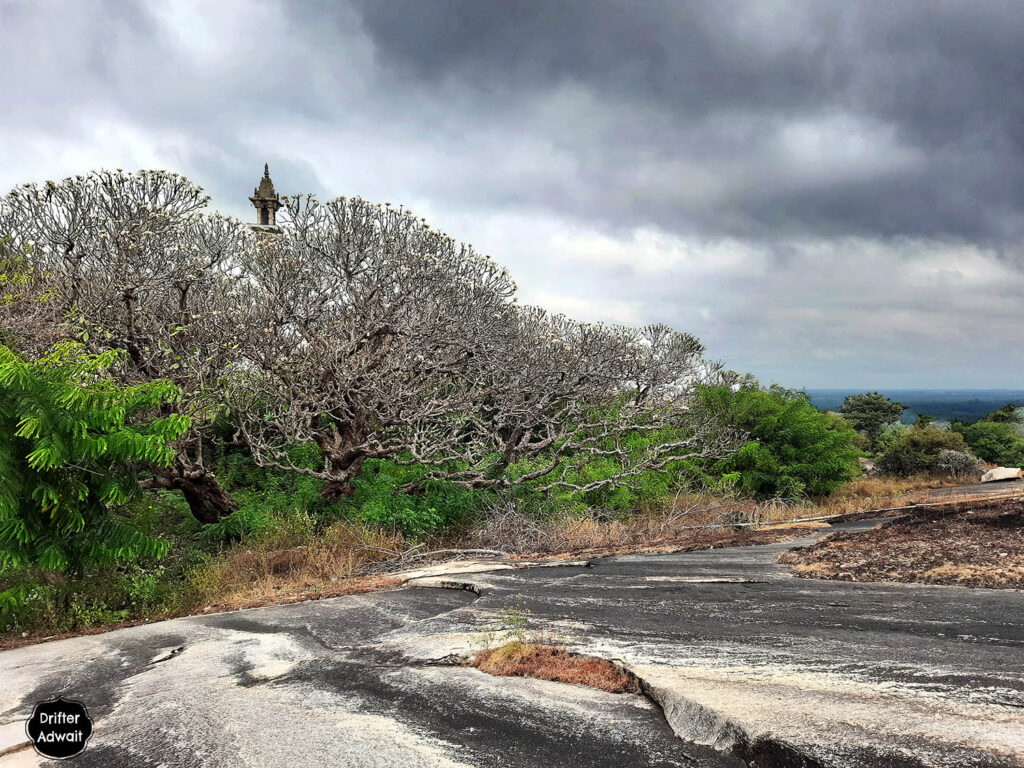
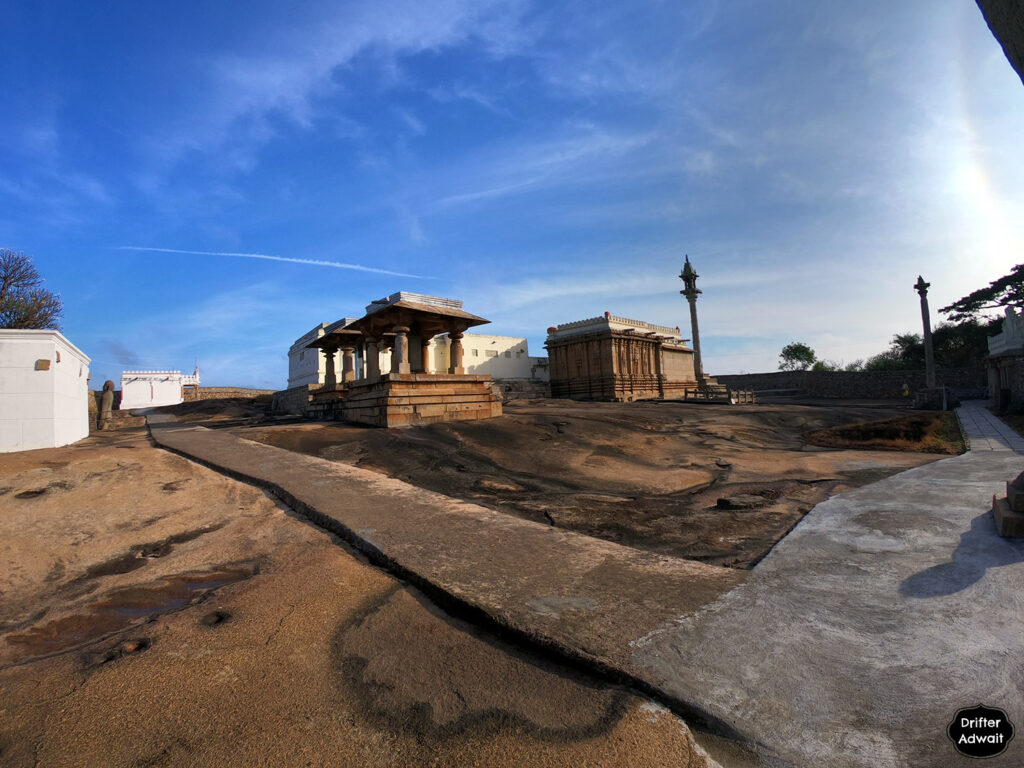
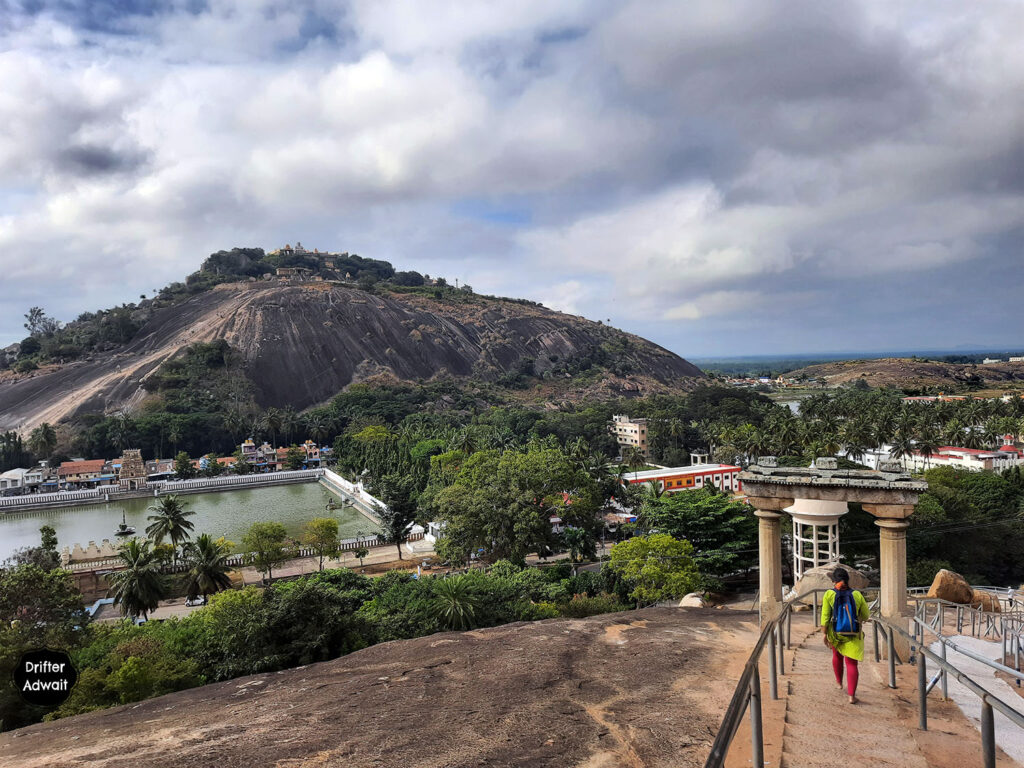

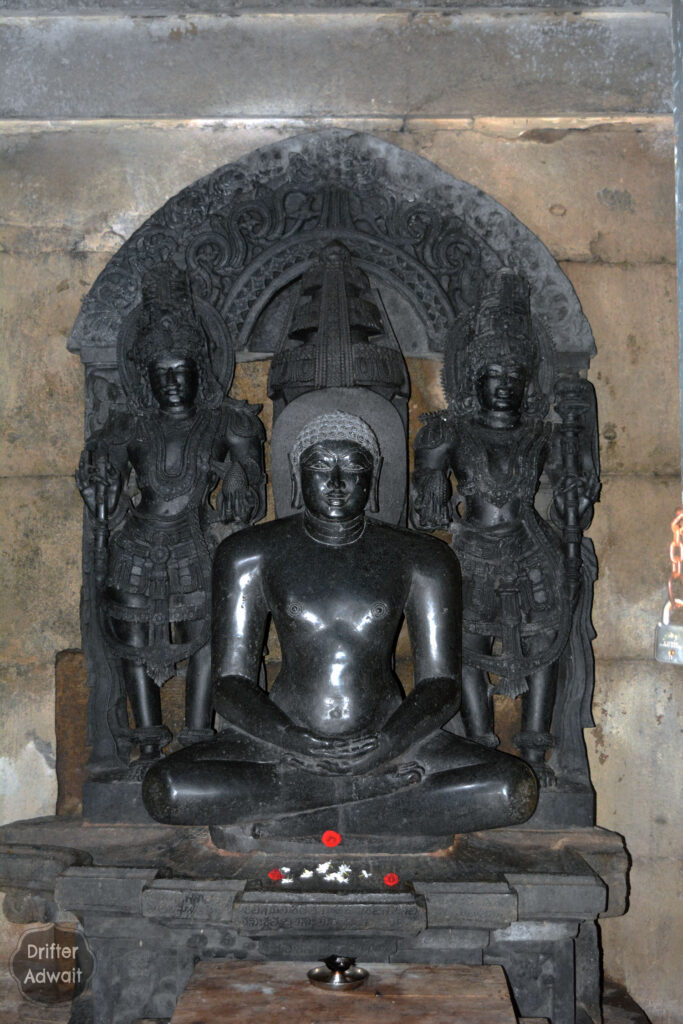
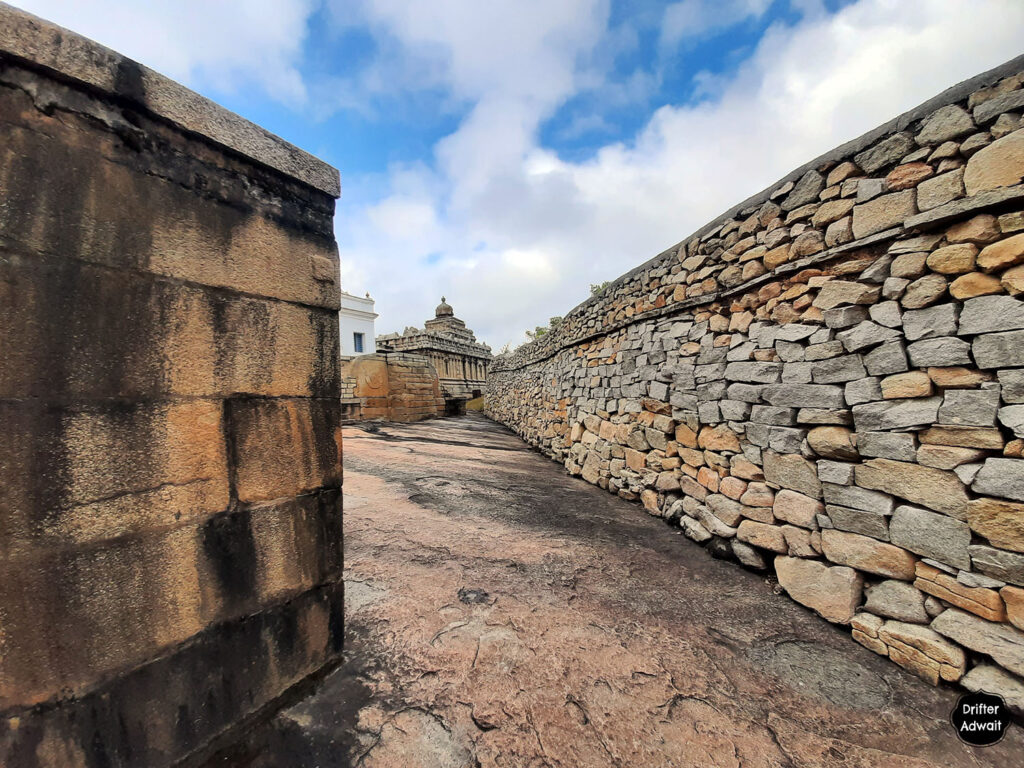
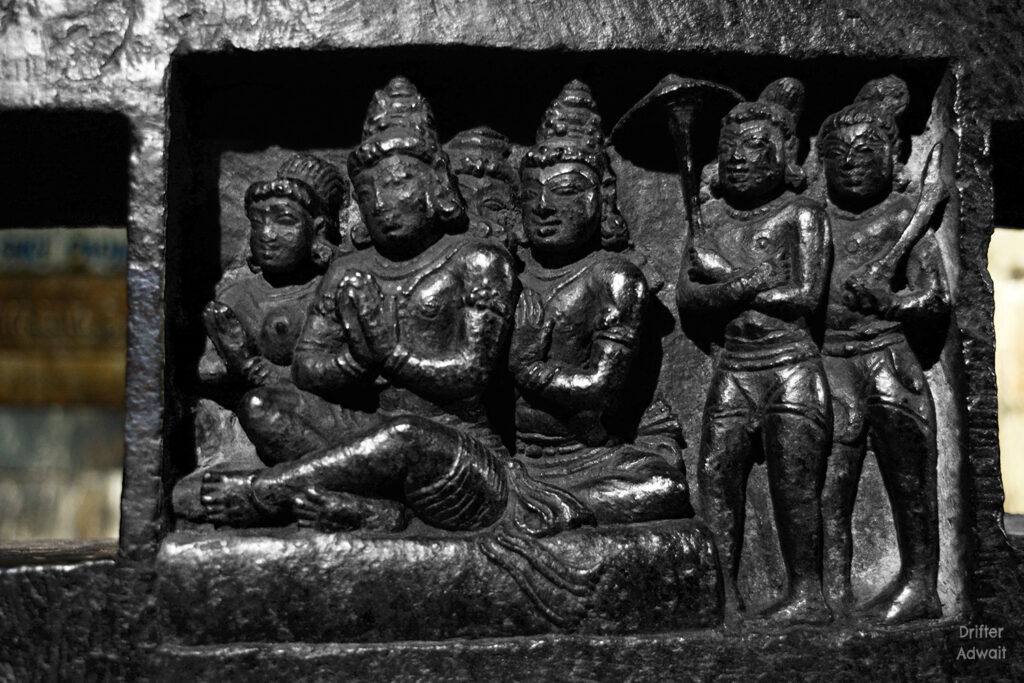
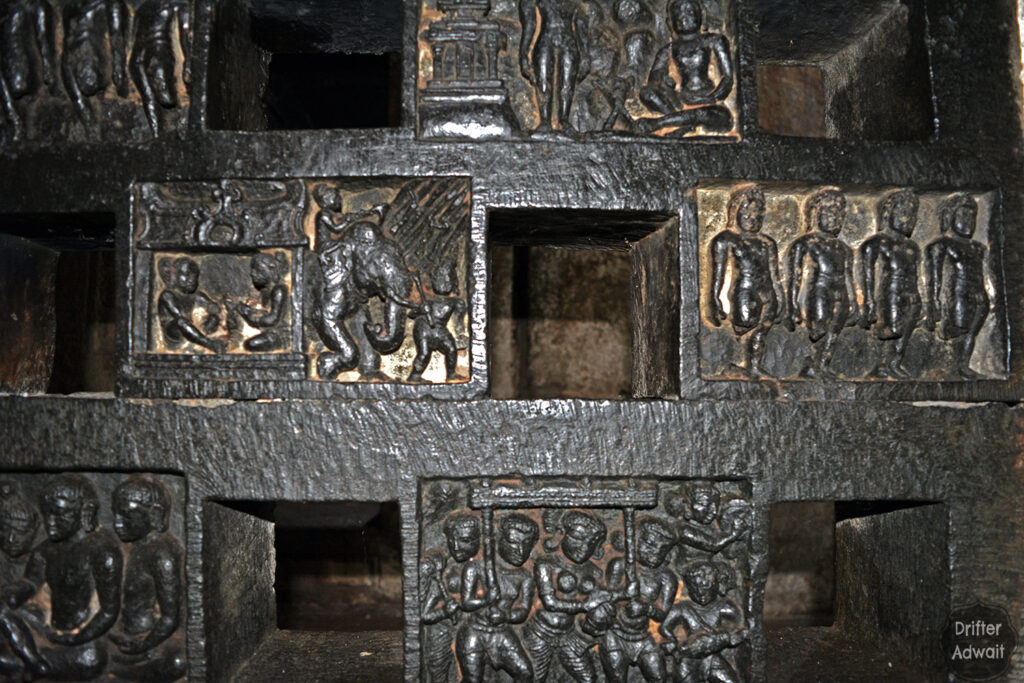
References:
1. श्रवण बेलगोल और दक्षिण के अन्य जैन तीर्थ, by राजकृष्ण जैन, publisher वीरसेवा मंदिर, दिल्ली
2. https://en.wikipedia.org/wiki/Bhadrabahu
3. New Perspectives on Jain Architecture and Sculpture at Sravana Belagola, Nalini Rao, Soka University, 6-15-2020, International Journal of Indic Religions
4. Chandragupta Maurya in Jain traditions – A study, Dr. Mune Gowda M, PU college, Yelhanka, Bangalore.
